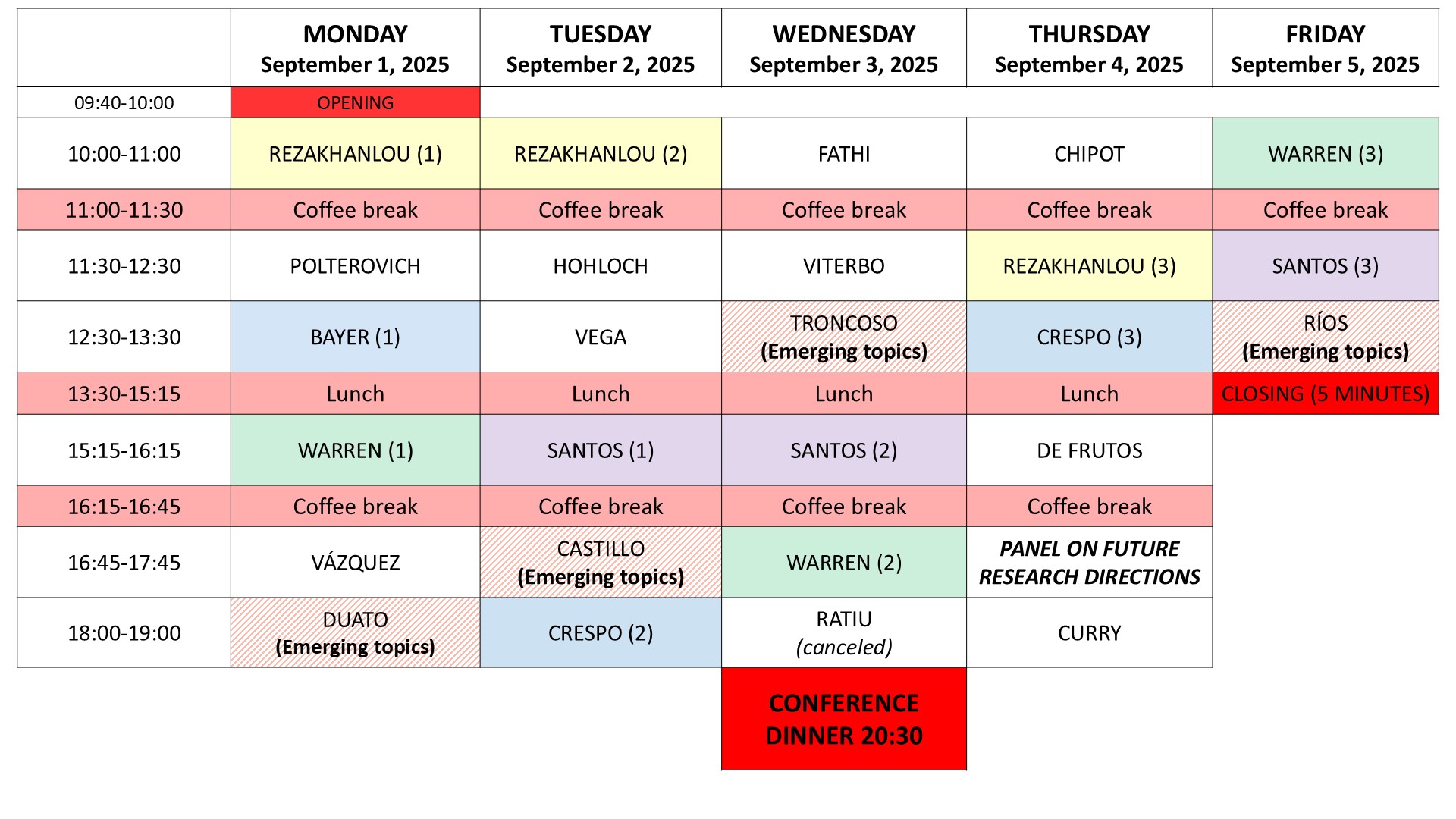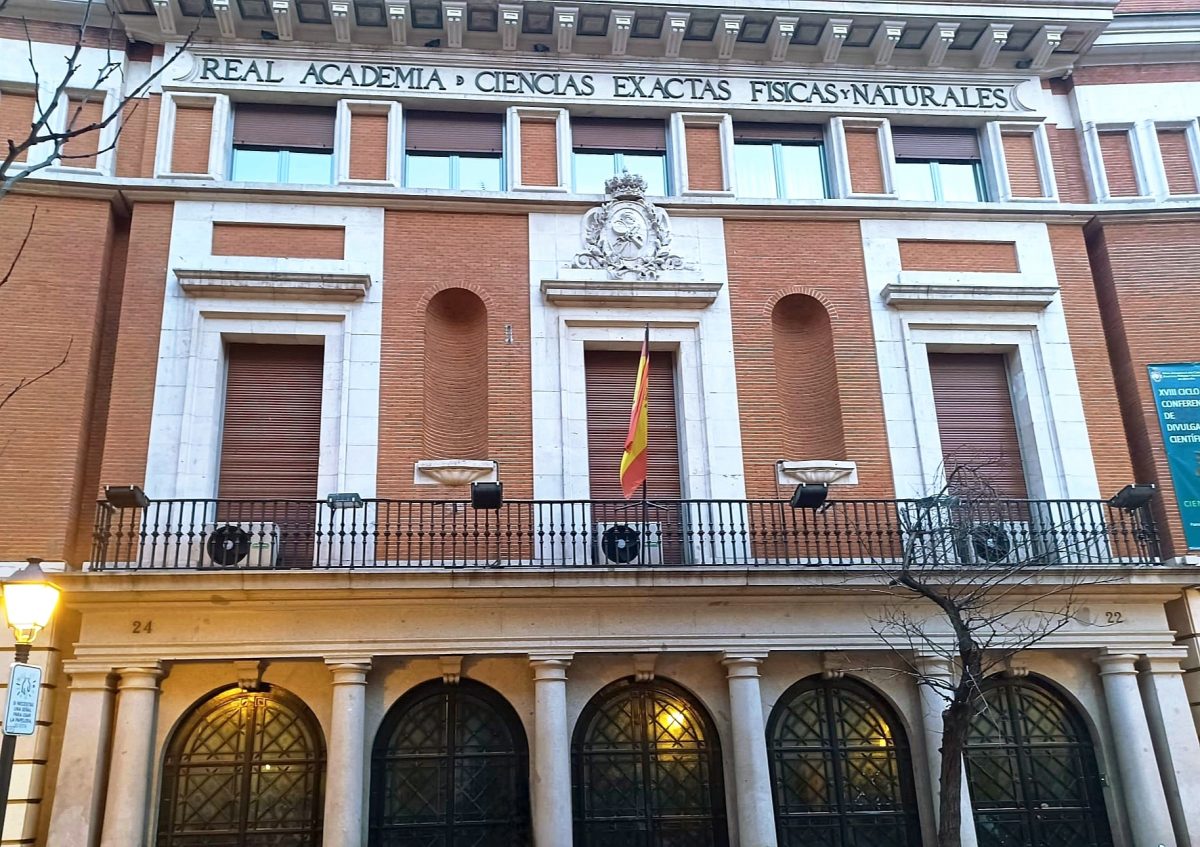DYNAMICS AND ANALYSIS IN INTERACTION
Quantum, statistical, computational and p-adic challenges
Monday September 1 to Friday September 5, 2025
Royal Spanish Academy of Sciences (RAC)
(Madrid downtown, Spain)
This is a five-day long conference focused on Dynamics and Analysis, as well as their interactions with:
- Probability and Statistics;
- Nonlinear Partial Differential Equations;
- Real and p-adic Symplectic Geometry, Integrable Hamiltonian Systems;
- Homotopy Type Theory and Computer Proof Assistants.
The conference, which will take place at the RAC Green Auditorium, includes 4 minicourses, 10 plenary lectures and 4 lectures on emerging topics. All funding for this conference is provided by the BBVA (Bank Bilbao Vizcaya Argentaria) Foundation through the grant From Integrability to Randomness in Symplectic and Quantum Geometry with Principal Investigator Álvaro Pelayo.
The conference opening and closing include a strong institutional respresentation: each will be chaired by a Vicepresident of the Complutense University of Madrid. The Vice President of the Royal Spanish Academy of Sciences and the Dean of the School of Mathematical Sciences of the Complutense University will also speak at the opening.
♦ SCHEDULE ♦
IMPORTANT: Since the conference runs on a tight schedule, speakers are strongly encouraged to stay within the time limits: maximum, a 50 minute-long lecture. You may want to time your talk before the actual presentation. Thank you very much!
♦ CONFERENCE OPENING ♦
Isabel García (Complutense University of Madrid Vicepresident for Culture, Athletics and Extracurricular Activities), Chair
Antonio Brú (Dean of the School of Mathematical Sciences of the Complutense University of Madrid, Spain)
Esteban Domingo (Vice President, Royal Spanish Academy of Sciences, Spain)
Álvaro Pelayo (Complutense University of Madrid and Royal Spanish Academy of Sciences, Spain)
♦ MINICOURSES ♦
Each minicourse consists of three 50-minute long lectures, each followed by up to 10 minutes of questions. The first two lectures of each minicourse should be understandable to graduate students in mathematics.
__________________________________________________
Pilar Bayer (University of Barcelona and Royal Spanish Academy of Sciences Spain);
Luis Crespo (University of Cantabria, Spain)
Number theory and p-adic models in differential geometry and mathematical physics
The first lecture, delivered by Bayer, will introduce the p-adic numbers and their main properties and comment on their importance in number theory, see this paper and this other one for background on this lecture (for related other works by Bayer in this direction see L’Enseignement Mathématique 1987 and J. Reine Angew. Math. 1999). The second and third lectures, by Crespo, will introduce a new approach to symplectic geometry and integrable systems based on replacing the real numbers by the p-adic numbers: here topics discussed will include a p-adic analog of Darboux´s Theorem, a discussion of the impossibility of a p-adic Non-squeezing Theorem (like Gromov´s Theorem in the the real case), integrable systems and applications to physics. Crespo´s lectures are based on this JNLS 2025 paper , and the 2025 preprints: preprint 1, preprint 2, preprint 3.
__________________________________________________
Fraydoun Rezakhanlou (University of California Berkeley, USA)
Probability, statistics and dynamics in interaction: stochastic geometry and Arnold’s Conjecture
I will introduce and discuss new interactions between statistics and the theory of dynamical systems that have come to light in recent years. In particular I will explain how some seminal theorems in symplectic topology and Hamiltonian dynamics due to Charles Conley, Eduard Zehnder and Andreas Floer (1980s) have inspired new probabilistic and statistical results about the existence and density of fixed points in the field of stochastic dynamics. This minicourse is inspired and motivated by Poincaré’s fundamental work on celestial mechanics and the restricted 3-body problem. The minicourse will be partly based on this CMP 2025 paper. For general background see the book by Hofer-Zehnder.
__________________________________________________
Francisco Santos (University of Cantabria and Royal Spanish Academy of Sciences, Spain)
A bridge between combinatorics and symplectic geometry
Delzant polytopes are the images of the moment maps of toric symplectic manifolds. Their combinatorics has been studied since the 1980’s mostly for their connections to toric algebraic geometry. In the first lecture we will review general questions about lattice polytopes. In the other two lectures we will study “The space of Delzant polytopes”, meant as a model for the space of symplectic toric varieties, and “smooth reflexive polytopes”, which are the polytopes associated to monotone symplectic toric varieties. We will discuss several conjectures of Oda, Ewald and Nill, and a question of McDuff. For lecture 1 see the lectures notes and the book; Lectures 2 and 3 are mostly based on material from the preprints one, two, and three (to appear in Ann. SNS. Pisa).
__________________________________________________
Michael A. Warren (Senior Director, BlueRaven AI, Los Angeles, USA)
Proof assistants and proof automation, an introduction to Homotopy Type Theory and Voevodsky´s Program via the univalent construction of the p-adic numbers
In this minicourse we will provide an introduction to proof assistants (e.g., Rocq, Lean) and the formalization of mathematics therein. This introduction will be framed around the construction of the p-adic numbers from Voevodsky’s Univalent Foundations program. Additional consideration will be given to the mathematical models underlying Univalent Foundations, the recent use of AI and machine learning to assist in the formalization of mathematics, and related topics. This course will provide attendees with a starting point from which to further explore the world of formalized mathematics. References for this talk are Voevodsky´s letter and Hales TC Lecture Notes in Logic ¨Mathematics in the age of the Turing machine¨ In: Downey R, ed. Turing’s Legacy: Developments from Turing’s Ideas in Logic. The course will discuss content from this paper and also this Bull. AMS paper.
♦ PLENARY LECTURES ♦
Each plenary lecture lasts for 50 minutes, followed by 10 minutes of questions. The first half of the talk should be understandable to a general audience of mathematicians who may not be specialists on the topic.
__________________________________________________
Michel Chipot (University of Zurich, Switzerland)
Asymptotic behavior of anisotropic problems
The goal of this talk is to explore the asymptotic behavior of anisotropic problems governed by operators of the pseudo p-Laplacian type.
__________________________________________________
(Update of September 2025: Sean Curry´s talk has been cancelled)
Sean Curry* (Oklahoma State University, USA)
Boundary behavior of geodesics in compactified geometries
I’ll present work from an ongoing project with Achinta Nandi where we develop results on the boundary behavior of the cogeodesic flow in Riemannian manifolds whose geometry is asymptotic to that of the real or complex hyperbolic spaces in a weak sense, with a view to applications to boundary regularity problems in complex analysis.
__________________________________________________
María Inés de Frutos (University of Bonn, Germany)
Formalizing Local Fields in Lean
In this talk, I will present a formalization in the Lean theorem prover of the basic theory of local fields and, more generally, of fields with a discrete valuation. Examples of local fields include finite field extensions of the p-adic numbers. This project is joint work with Filippo A. E. Nuccio Mortarino Majno di Capriglio.
__________________________________________________
Max Fathi (University of Paris Cité, France)
Cutoff phenomenon for nonlinear diffusion equations : a few examples
The cutoff phenomenon is a now classical topic in probability, that consists in proving an abrupt convergence to equilibrium for a sequence of Markovian dynamics. Classical examples include card shuffles, random walks on groups and graphs, or interacting particle systems. In this talk I will present an overview of the topic, and discuss some examples of cutoff for porous medium and fast diffusion equations in high dimension. Joint work with Djalil Chafaï and Nikita Simonov.
__________________________________________________
Sonja Hohloch (University of Antwerp, Belgium)
Towards a classification of hypersemitoric systems
Integtrable systems are dynamical systems with many conserved quantities. In 1988, Delzant symplectically classified integrable systems of toric type in terms of polytopes. Semitoric systems are integrable systems which generalize toric systems in dimension four by admitting in addition to elliptic-elliptic and elliptic-regular singularities also focus-focus singularities. In 2009-2011, Pelayo and Vu Ngoc symplecticaly classified semitoric integrable systems in terms of 5 invariants, among which a generalized semitoric polytope deduced from the momentum map image, i.e. generalizing the Delzant polytope. Semitoric systems can be generalized to what we call hypersemitoric ones, which also admit hyperbolic singularities. I will give a colloquium style introduction to integrable systems and then address the state of the art of the classification of hypersemitoric systems.
__________________________________________________
Leonid Polterovich (Tel Aviv University, Israel)
Contact topology meets thermodynamics
I discuss the appearance of certain notions and results from contact topology in both equilibrium and non-equilibrium thermodynamics. These include non-smooth Legendrian submanifolds, Reeb chords, and the partial order on the space of Legendrians. Based on joint work with Michael Entov and Lenya Ryzhik.
__________________________________________________
(Update of August 2025: Tudor Ratiu´s talk has been cancelled)
Tudor Ratiu (Shanghai Jiao Tong University, China)
Memorial Lecture dedicated to Pedro L. García Pérez
Variational principles in stochastic mechanics with applications to compressible Navier-Stokes
The Euler-Poincaré constrained variational principle for semidirect products is presented and then formulated in a stochastic setting. It yields both deterministic and stochastic SDEs, depending on the chosen drift vector fields. The same techniques are extended to derive both stochastic versions and the classical deterministic compressible Navier-Stokes equations without any appeal to thermodynamics.
__________________________________________________
Juan Luis Vázquez (Autonomous University of Madrid and Royal Spanish Academy of Sciences, Spain)
The mathematical theories of linear and nonlinear diffusion
This is a classic topic of partial differential equations, whose rapid progress is based on the close interaction with various disciplines,mainly physics, functional analysis, probability, and ODEs, which served to set its foundations, as well as recent relationships with geometry, image processing, finance, biology, and the computing world.
__________________________________________________
Luis Vega (Basque Center for Applied Mathematics and Royal Spanish Academy of Sciences, Spain)
The dynamics of viscous vortex filaments and the Binormal Curvature Flow
I’ll present some recent work about the connection of vortex filaments/tubes that move according to Navier Stokes Equation and the binormal curvature flow of curves in 3d. This is a joint work with Marco A. Fontelos
__________________________________________________
Claude Viterbo (University of Paris-Saclay, France)
Stochastic homogenization for Hamilton-Jacobi equations
We consider a stochastic Hamiltonian on the cotangent bundle of the n-dimensional Euclidean space. Under suitable assumptions (mostly coercivity), we prove that variational solutions for the Cauchy problem of a naturally associated Hamilton-Jacobi equation converge in a precise stochastic sense. The proof is based on symplectic topology in a non-compact setting.
♦ DISTINGUISHED LECTURES ON EMERGING TOPICS ♦
These are colloquium style lectures on emerging topics of exceptional interest and applicability in which mathematics plays a role. Each lecture lasts for 50 minutes, followed by 10 minutes of questions.
__________________________________________________
Enrique Castillo (University of Cantabria, Royal Spanish Academy of Engineering and Royal Spanish Academy of Sciences, Spain)
EMERGING TOPICS IN …. In search of families of functions mentioned in Buckingham’s Pi theorem. Extension to random variables and their relationship with copulas
Aggregation properties and functional equations are used to obtain very general families of functions that allow the Buckingham Pi theorem to be used to solve problems in physics and engineering with great generality. It is observed that in a very simple way, deterministic models can be extended to random models, which extends their interpretation to the random field and makes them even more useful. From this perspective, the role of copulas becomes relevant for understanding the interactions between variables once the effects of the individual actions of the different variables in the models have been eliminated. In all this, ordering and order statistics play an important role. Finally, examples of fatigue problems and their modeling are shown.
__________________________________________________
Jose Duato (Royal Spanish Academy of Sciences and CTO at Qsimov Quantum Computing Ltd., Spain)
EMERGING TOPICS IN … Towards environmentally friendly artificial intelligence systems
Applications based on different artificial intelligence (AI) techniques are being implemented and deployed at an unprecedented rate but the electrical energy consumption associated with AI is reaching alarming levels. In this lecture, after reviewing the main mathematical and hardware advances in the field of AI, a new AI system is proposed that aims to achieve a drastic reduction in energy consumption in those cases where frequent retraining with additional data is required. This system is proposed as an alternative to deep neural networks and is based on a groundbreaking approach, whose fundamental advantages will be discussed and evaluated.
__________________________________________________
David Ríos (ICMAT-CSIC and Royal Spanish Academy of Sciences, Spain)
EMERGING TOPICS IN … Adversarial machine learning
Machine learning (ML) is the subfield that is having major impact in the growth (and hype) of AI and leading to its almost ubiquitous deployment in Science, Health, Defense or Entertainment, to name but a few. Yet ML algorithms are susceptible of attacks leading to the emerging area of adversarial machine learning (AML). I shall present core problems in the AML area, describe some solutions and introduce some open problems targeting the provision of more secure ML systems and services.
__________________________________________________
Alicia Troncoso (Pablo de Olavide University and President of the Spanish Association of Artifical Intelligence, Spain)
EMERGING TOPICS IN … From foundations to explainability in the age of ArtificiaI Intelligence
Emerging topic in…eXplainable Artificial Intelligence (XAI). This talk explores the vital role of explainability in modern machine learning. We begin with historical roots, including foundational contributions and the evolution of AI paradigms. Next, we provide an intuitive introduction, demystifying how AI models make decisions. Despite the remarkable capabilities of machine learning models, their inherent complexity leads to a lack of transparency and interpretability. This opacity is especially problematic in critical applications. Finally, we address recent research and challenges in explainable AI, highlighting the importance of trust, fairness, and accountability in AI.
♦ PANEL ON FUTURE RESEARCH DIRECTIONS ♦
Each member of the panel has been asked to present math open problems or directions during approximately 5-10 minutes. The panelists can assume, when presenting these problems/directions, that the audience is already familiar with the content of their previous lectures at the conference.
Sonja Hohloch (University of Antwerp, Belgium)
Fraydoun Rezakhanlou (University of California Berkeley, USA)
Juan Luis Vázquez (Autonomous University of Madrid and Royal Spanish Academy of Sciences, Spain)
Michael A. Warren (Senior Director, BlueRaven AI, Los Angeles, USA)
Discussion Moderator: Álvaro Pelayo (Complutense University of Madrid and Royal Spanish Academy of Sciences, Spain)
♦ Session Chairs ♦
Each day there are Chairs in charge of presenting the talks. Chairs have been asked to stand up when there are two minutes remaining till the end of the talk, in order to help speakers keep track of time.
- Chair of Monday morning session: Manuel López-Pellicer (Technological University of Valencia and Royal Spanish Academy of Sciences, Spain)
- Chair of Monday afternoon session: Álvaro Pelayo (Complutense University of Madrid and Royal Spanish Academy of Sciences, Spain)
- Chair of Tuesday morning session: Álvaro Pelayo (Complutense University of Madrid and Royal Spanish Academy of Sciences, Spain)
- Chair of Tuesday afternoon session: Antonio Díaz-Cano (Complutense University of Madrid and Institute of Interdisciplinariy Mathematics, Spain)
- Chair of Wednesday morning session: Leonid Polterovich (Tel Aviv University, Israel)
- Chair of Wednesday afternoon session: Álvaro Pelayo (Complutense University of Madrid and Royal Spanish Academy of Sciences, Spain)
- Chair of Thursday morning session: Manuel de León (ICMAT-CSIC and Royal Spanish Academy of Sciences, Spain)
- Chair of Thursday afternoon session: Michael A. Warren (Senior Director, BlueRaven AI, Los Angeles, USA)
- Chair of Friday session: Álvaro Pelayo (Complutense University of Madrid and Royal Spanish Academy of Sciences, Spain)
♦ CONFERENCE CLOSING ♦
Antonio Díaz-Cano (Complutense University of Madrid and Institute of Interdisciplinariy Mathematics, Spain)
Álvaro Pelayo (Complutense University of Madrid and Royal Spanish Academy of Sciences, Spain)
♦ Advisory Committee ♦
José Bonet (Technological University of Valencia and Secretary of the Royal Spanish Academy of Sciences, Spain)
Ildefonso Díaz (Complutense University of Madrid and Head of the Division of Mathematical Sciences of the Royal Spanish Academy of Sciences, Spain)
Gustavo Muñoz (Complutense University of Madrid and Head of the Institute of Interdisciplinary Mathematics, Spain)
♦ Organizing Committee ♦
Antonio Díaz-Cano (Complutense University of Madrid and Institute of Interdisciplinariy Mathematics, Spain)
Álvaro Pelayo (Complutense University of Madrid and Royal Spanish Academy of Sciences, Spain)
The conference is organized in collaboration with the RAC and the Complutense University of Madrid (Institute for Interdisciplinary Mathematics IMI and School of Mathematical Sciences).
♦ Administrative Assistant ♦
Ruben Sánchez, at the address below, is the only administrative contact for the conference:
Ruben Sánchez (Secretary, Institute of Interdisciplinary Mathematics IMI, Complutense University of Madrid)
E-mail: secreadm.imi@mat.ucm.es
ALL FUNDING FOR THIS CONFERENCE IS generously PROVIDED BY THE BANK BBVA (BilbaO Vizcaya Argentaria) FOUNDATION VIA Álvaro pelayo´s FBBVA GRANT ¨from integrability to randomness in symplectic and quantum geometry¨.
In a time of dangerous specialization we should feel free to use all tools available to us, and use them with proper taste. To me it seems idle to argue whether to prefer solving of challenging problems, building of abstract structures, or working on applications. Rather we should keep an open mind when we approach new problems, and not forget the unity of mathematics.
Jürgen Moser

